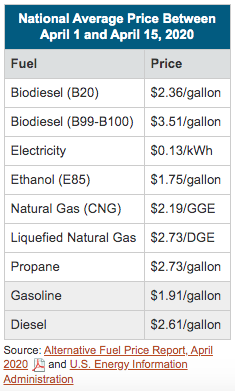How does one build the case for backing clean transportation and sustainability initiatives during a time like this? The US is  facing increasing COVID-19 infection and fatality rates, outrage over racial profiling and use of force by police, depressing economic indicators, and gasoline prices staying quite cheap.
facing increasing COVID-19 infection and fatality rates, outrage over racial profiling and use of force by police, depressing economic indicators, and gasoline prices staying quite cheap.
Electric car sales have been hit by the unexpected impact of COVID-19 — but at a much slower decline than overall new vehicles sales in the US. Converting vehicle owners — whether consumers, fleets, or trucking companies — over to clean vehicles, and the necessary charging and refueling infrastructure, is a much harder sell this year.
Events have been cancelled such as the popular ACT Expo in May, and many other conferences and exhibit halls. Some are being carried forward through online events — see news section below for news on one of these upcoming events.
Concerns over air pollution and climate change have been down on the scale lately. But its also an opportunity for stakeholders to reach out and practice social responsibility, according to a sustainability expert.
During a LinkedIn discussion group last week, that question was raised. Leaders in disease prevention, healthcare, social justice, and economic recovery, must be engaged and listened to with empathy, according to a prominent sustainability consultant. That could take place during a Zoom meeting or through other useful communication tools. They can’t be brushed off, he said.
That’s been reinforced by a recent Bain & Company report, as the impact of COVID-19 has been serving as something of a dress rehearsal for corporations preparing for the next disasters through climate change. Telework and virtual meetings have been reducing travel and forcing other alternatives on company operations. Satellite images have been reporting a steep decline in air pollution — showing the dramatic impact of taking away fossil fuel emissions. Another positive trend has been seeing corporations working closely with government agencies on accurate reporting of Coronavirus symptoms, testing, and how to practice social distancing and other safe practices.
Supporting disadvantaged communities
For those working in clean transportation and sustainability, the resources are there in government funding and incentives — and in investment funds in sustainability, social responsibility and ESG (Environmental, Social, and Governance). And there’s another opportunity to rejuvenate — tapping into government programs and alliances supporting clean transportation in disadvantaged communities.
California legislators winning over votes in Sacramento have emphasized the health risks for those living close to ports, cargo transport hubs, streets, and highways packed with diesel-powered commercial vehicles. Environmental justice is emphasized by legislators and community groups making the case for clean vehicles and fuels to displace traditional internal combustion engine vehicles.
The Greelining Institute, based in Oakland, Calif., sees economic barriers faced by communities of color as interconnected to several issues affecting quality of life. Vehicle exhaust makes tens of thousands of Californians sick and costs billions in avoidable health costs, with the worst effects often felt in low-income communities of color, the organization says.
The organization sees a clear correlation between economic opportunity — through job creation, support services, education, and other resources — and overcoming racial inequality. Breathing cleaner air is also part of tapping into government and business support for improving quality of life and leveling out the playing field.
“Race must never be a barrier to opportunity,” according to Greenlining.
Other states are including economic disadvantages in their framework for regions needing more electric vehicles and charging infrastructure to improve quality of life and address health concerns. Some of these states outside California with laws and funded programs in effect, or being considered by legislators, include Washington, Oregon, New York, New Jersey, and North Carolina.
Demand for disaster preparedness
In the fall of 2012, Hurricane Sandy’s impact was devastating, causing about $65 billion in damage. It eventually reached New Jersey and New York City, flooding streets, parking lots, tunnels and subway lines, and cutting power in and around the city. Now-defunct Fisker Automotive reported that 320 Fisker Karmas were destroyed at a New Jersey port by Hurricane Sandy.
In the immediate years that followed, the impact of climate change spread far beyond scientists and environmental groups. It became common to hear it referred to as “climate disruption” as a series of severe weather disasters on both ends of the spectrum were unleashed — from blizzards to heatwaves, brushfires, hurricanes, tsunamis, tornados, and earthquakes. The impact has been devastating in lives lost, property destruction, and disruptive weather conditions outside what we’d been used to.
There’s been a growing need in finding skilled and experienced professionals who can protect public safety and restore damaged infrastructure. Engineering and consulting firms are being hired to address disaster mitigation, infrastructure protection, and bringing resilience back to impacted communities. COVID-19, and social upheaval across the country, have brought up even greater challenges.
Fleet professionals that I know have engaged me and many others in conversations on challenges they’ve been through such as flooding and power outage. Their stories have been sad — with millions of dollars on loss due to vehicles being unsalvageable due to flooding that had not been seen in previous years. Opportunities have also come through it — with fleet professionals gaining experience and technical know-how in utilizing electric vehicle battery packs for energy storage.
And in other news……..
California adopting clean truck rules: On Friday, the California Air Resources Board passed a unanimous vote for the Advanced Clean Trucks Regulation, which will require truck manufacturers to sell a certain percentage of zero-emission trucks in the state starting in 2024. It will see a gradual annual increase in adding more electric trucks to fleets, with the goal of putting 300,000 electric trucks on California’s roads by 2035 and phasing out diesel trucks by 2045. Heavy-duty trucks are considered to be responsible for a third of California’s smog-causing nitrogen oxides (NOx) pollution and a fifth of its greenhouse gases.
Virtual clean transportation conference coming up: AltWheels 2020 will be hosting its first ever virtual event on Monday, Oct. 5, 2020. The Boston conference started 17 years ago and became fleet-focused 14 years ago. The event organizers want to make sure that fleets and other stakeholders will be able to continue attending and sharing information on making clean transportation work. Green Auto Market will serve as one of the co-hosts of the conference, and will be covering the event throughout the year.
Fleet Day at AltWheels 2020 will include speakers and a breakout session, exhibits, along with leading alternative vehicles of all sizes and the latest options for fleet managers. Last year’s event featured 30 expert speakers, 31 exhibits, and 20 on-site vehicles for display. More than 200 fleet managers from corporate, municipal, and state organizations from across New England and New York were in attendance last year. It provides attendees an opportunity to gain the latest updates in fleet transportation technologies, alternative fuels, and fleet management practices. Further information on AltWheels Fleet Day including photos and videos of last year’s sessions is available online at this website.
Resources to Tap Into:
—Research Determines Financial Benefit from Driving Electric Vehicles
Over a 15-Year Life, EVs Can Save Thousands of Dollars in Fuel Costs Compared to Gasoline Vehicles
Click here for analysis conducted by researchers at the U.S. Department of Energy’s (DOE’s) National Renewable Energy Laboratory (NREL) and Idaho National Laboratory (INL).
—How to Leverage LCFS to Increase EV Sales: OEMs and Dealers Toolkit
Click here for a study from GNA and ACT News.
Connecting the Dots
Market data to follow

AAA reports that the national average for regular gasoline as of June 28 was at $2.178, and diesel came in at $2.441. Natural gas continues to have stable and competitive gallon gas equivalent (GGE) pricing compared to gasoline and diesel. Ethanol is even more competitive, with most of it consumed through E-10 blends. US Energy Information Administration reports that there are about 3,625 public E85 fueling stations are located around the country. Most of that takes place in the Midwest.
